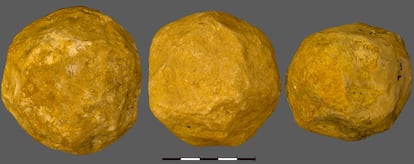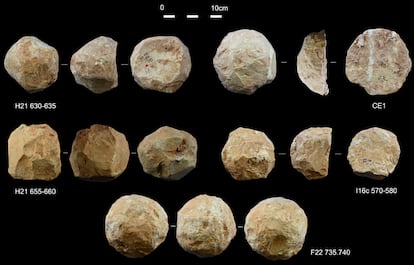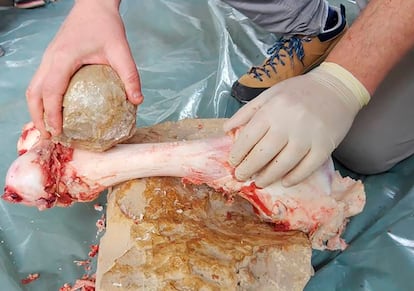The mystery of stone spheres and mankind’s most enduring technology
For decades, scientists have pondered the usefulness of certain carved balls found at sites dating back a million and a half years

When it was believed that humans had appeared suddenly, planted on Earth by a divine act of God, separated from the rest of the animals, it was possible to study their nature by observing how they behaved in the present-day societies. The situation became more complicated when, in the light of the theory of evolution, we learned that we were just another branch of the tree of life, and that we shared ancestors, even though there are millions of years between us and other animals. In the search for the spark that produced this species capable of amassing knowledge, communicating it and transforming its environment like no other before, scientists have sought to go beyond academic speculation and get their hands dirty, scratching the ground in caves and ravines, looking for answers.
One of the sites where the reconstruction of the origins of human culture is being pursued is the Ubeidiya prehistoric site, located in northern Israel. Since the 1960s, the oldest Acheulean hand axes outside Africa have been discovered there, as well as hundreds of enigmatic-looking stones, seemingly carved in the shape of a sphere the size of a tennis ball. These spheroids, which first appeared 1.7 million years ago in Africa, have been discovered halfway around the world, in sites separated by thousands of kilometers, from the Great Rift Valley to South Korea, or the Orce sites in Spain. They have been found for decades, but their nature remains a mystery. There is still debate as to whether they were made purposefully or are a casual product of the striking of other stones, and questions marks over what their purpose was.
This week, a team from the Catalan Institute of Human Paleoecology and Social Evolution (IPHES) in Tarragona and the Hebrew University of Jerusalem published a paper suggesting that they were carved intentionally. Using new 3D analysis techniques and following the marks on the stones, the researchers reconstructed the sequence that these hominids might have followed during their elaboration. Their findings indicate that, unlike when a shape results from erosion, as in the case of a pebble rolling down a river, the objects did not become smoother, but more spherical. “In our analysis we encountered a regularity, and that regularity suggests that an intention to develop these types of shapes was present,” points out Deborah Barsky, IPHES researcher and one of the authors of the paper. “These spheres could be the first geometric shapes recreated in stone in a premeditated way,” she claims.
Now, as part of a long-term project involving Barsky for the study of the spheroids, they will pursue their work to find out what these objects were created for. It has been proposed that they could be used to treat vegetables, to remove the marrow from bones or as hunting projectiles. It has also been suggested that they could have a symbolic value, something that would be more plausible if, as some authors propose, they were difficult to craft and required hours of work in comparison to the time required to make one of the versatile hand axes that usually accompany these stone balls at archaeological sites.

The axes and spheres reveal one of the most interesting episodes in the history of evolution and provide a glimpse into the emergence of the human mind. The first stone tools used by our ancestors, the Oldowan tools associated with Homo habilis, are made by hand, aiming for a useful shape, but with no precise thought. “However, Acheulean axes imply an ability to imagine the desired shape and make it out of rock, a bit like Michelangelo’s concept, when he said that the sculpture was already inside the stone and he only eliminated what was around it,” explains Juan Manuel Jiménez Arenas, who has studied the spheroids found at the Orce site, back in Granada.
“Oldowan cores and flakes do not require much cognitive ability or manual dexterity. We now see primates, such as the capuchin monkeys of Brazil, unintentionally producing sharp-edge stone flakes indistinguishable from what we find in the Oldowan style. However, Acheulean is a completely different game,” explains CSIC scientist Ignacio de la Torre, who describes an experiment that tested how well modern-day humans would be able to make tools. “Through emulation they were able to make Oldowan tools, without any explanation, but in the Acheulean they had to have the process explained to them, which implies the existence of a social context, in which there were masters and apprentices, and where there could be actual craftsmen,” adds de la Torre.

If the spheroids were made with intent, it demonstrates the appetite for symmetry of those new humans, Homo erectus, who walked the planet with the longest-lived technology known to man. For a million and a half years, in places thousands of kilometers apart, the same axes and the same spheres appear. This omnipresence of technology raises new questions. “Spheroids appear in Orce, in the south of the Iberian Peninsula, 400,000 years earlier than in the rest of Europe, which raises questions about the scattering of humans across this continent,” says Jiménez Arenas.
The emergence of the technology in Africa, the far east of Asia and the western confines of Europe is also food for thought as to how it got there. Barsky believes that this “does not mean that there was contact between populations” and she leans towards the idea that the members of the species “reached a cognitive and cultural level that allowed them to adopt the same responses to similar environmental circumstances.”
For a million and a half years, the axes and, in all probability, the stone balls show a surprising cultural cohesion in half the planet, which was no longer possible with the arrival of the innovative Homo sapiens. The rapid introduction of new technologies and cultural practices increased geographic heterogeneity. “[Erectus’] capacity for innovation was limited, but the fact that Acheulean technology was effective is evidenced by the fact that it lasted for a million and a half years. The hand axe is thought to have been a type of Swiss Army knife, which was used for almost everything, from skinning animals to cutting tubers,” explains Torre. “Our species is innovative by definition and when Homo sapiens appeared, archaeological cultures lasted less and less,” continues the researcher, before warning that: “Despite being less innovative, they survived a million and a half years, and it remains to be seen whether our species will be able to do so.”
Sign up for our weekly newsletter to get more English-language news coverage from EL PAÍS USA Edition
Tu suscripción se está usando en otro dispositivo
¿Quieres añadir otro usuario a tu suscripción?
Si continúas leyendo en este dispositivo, no se podrá leer en el otro.
FlechaTu suscripción se está usando en otro dispositivo y solo puedes acceder a EL PAÍS desde un dispositivo a la vez.
Si quieres compartir tu cuenta, cambia tu suscripción a la modalidad Premium, así podrás añadir otro usuario. Cada uno accederá con su propia cuenta de email, lo que os permitirá personalizar vuestra experiencia en EL PAÍS.
¿Tienes una suscripción de empresa? Accede aquí para contratar más cuentas.
En el caso de no saber quién está usando tu cuenta, te recomendamos cambiar tu contraseña aquí.
Si decides continuar compartiendo tu cuenta, este mensaje se mostrará en tu dispositivo y en el de la otra persona que está usando tu cuenta de forma indefinida, afectando a tu experiencia de lectura. Puedes consultar aquí los términos y condiciones de la suscripción digital.
More information
Archived In
Últimas noticias
Russell Tovey: ‘I was advised many times not to come out, I don’t think there was many people who’d done that — and I feel really proud that I’m one of those that did’
Merz tries to replace Macron at the helm of Europe
Indulgence, punishment and family dynamics: Maintaining a healthy relationship with food during the holiday season
Patagonia’s puma population soars thanks to unexpected prey: penguins
Most viewed
- The low-cost creative revolution: How technology is making art accessible to everyone
- Families demand repatriation of bodies of Colombians who died in Ukraine: ‘This war is a slaughterhouse for foreigners’
- Christian Louboutin: ‘Young people don’t want to be like their parents. And if their parents wear sneakers, they’re going to look for something else’
- US sanctions against jailed cartel leader ‘El Marro’ highlight Mexico’s lack of control over its prisons
- Liset Menéndez de la Prida, neuroscientist: ‘It’s not normal to constantly seek pleasure; it’s important to be bored, to be calm’










































